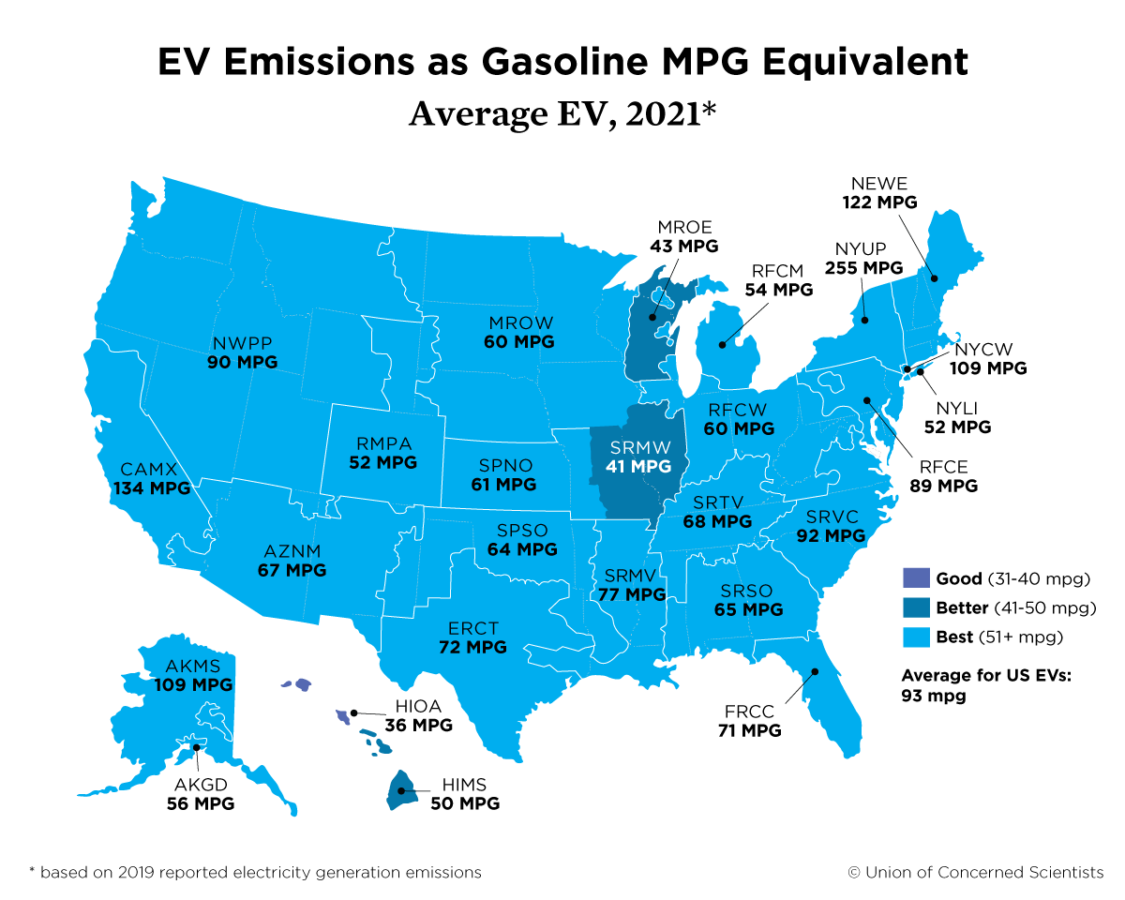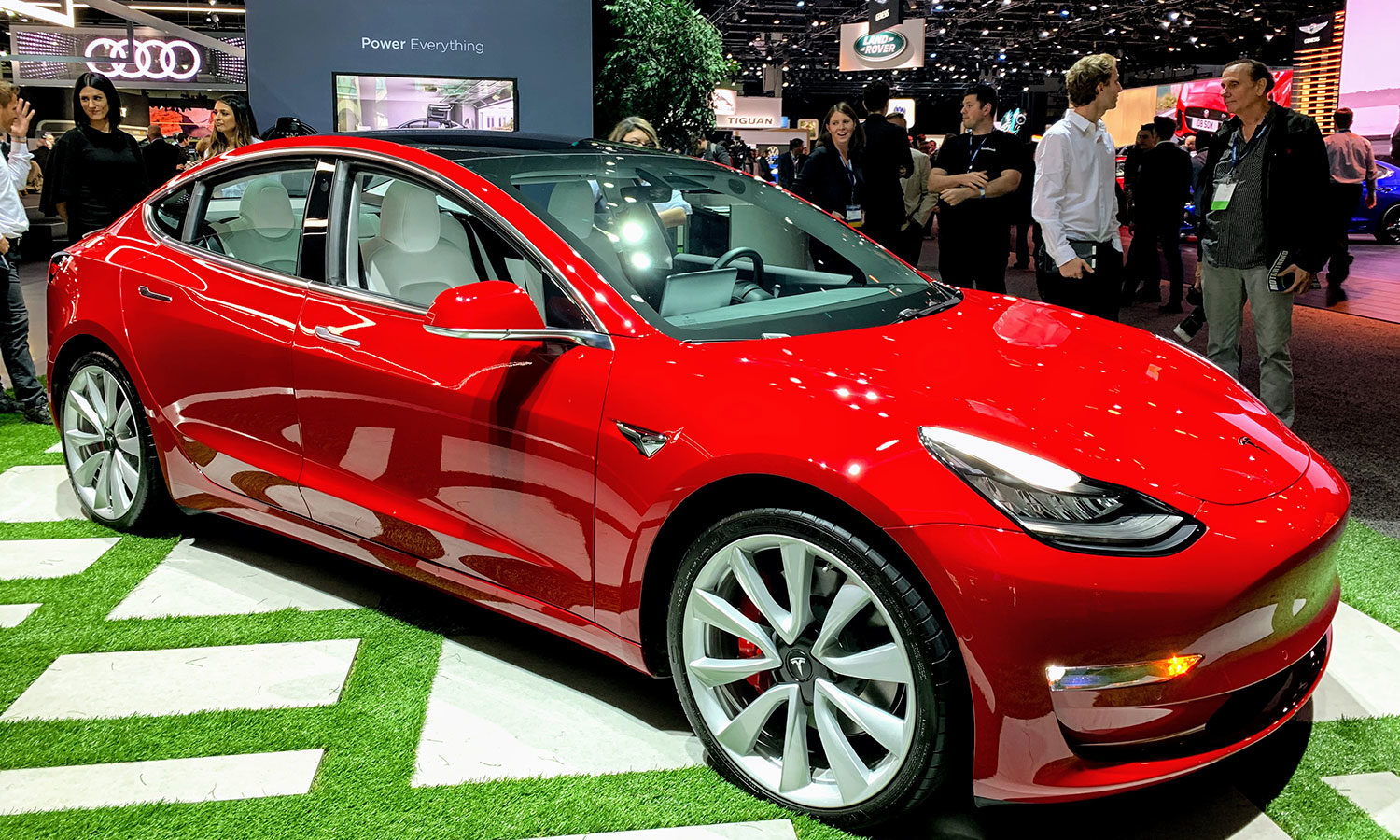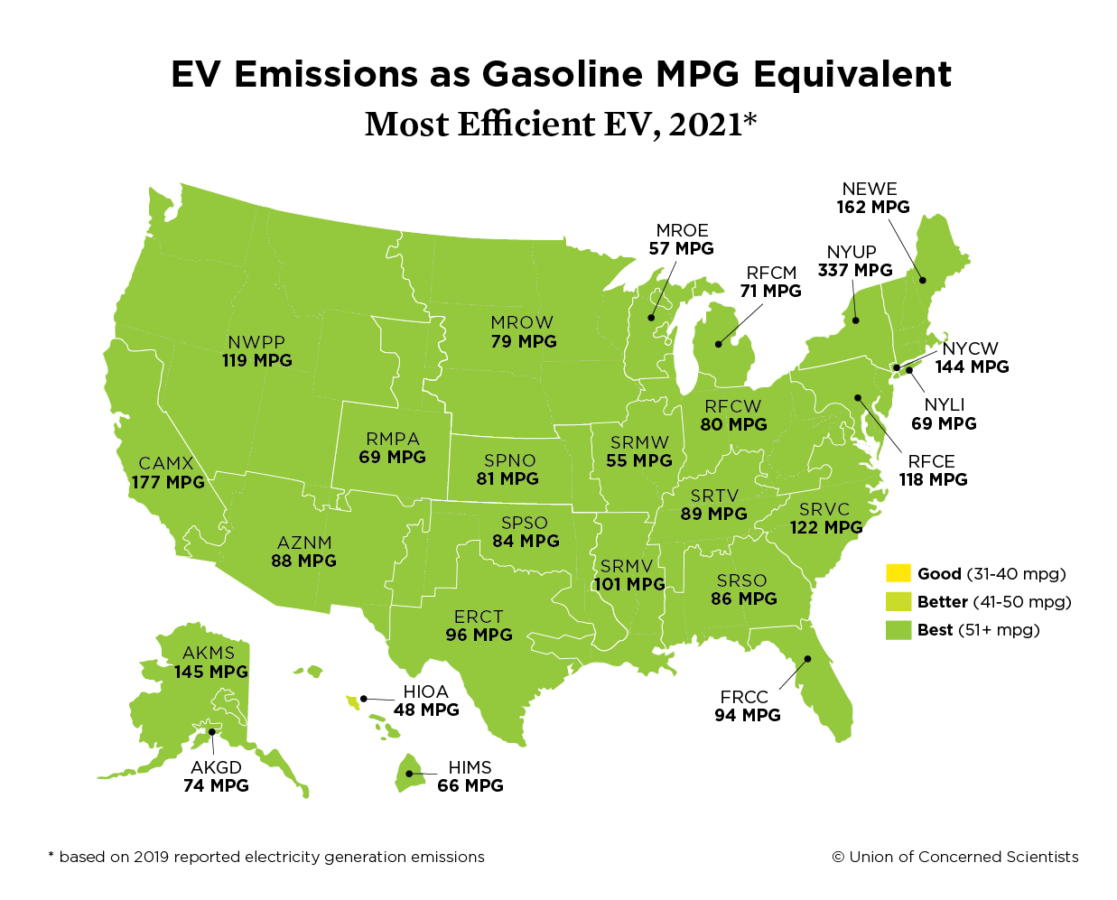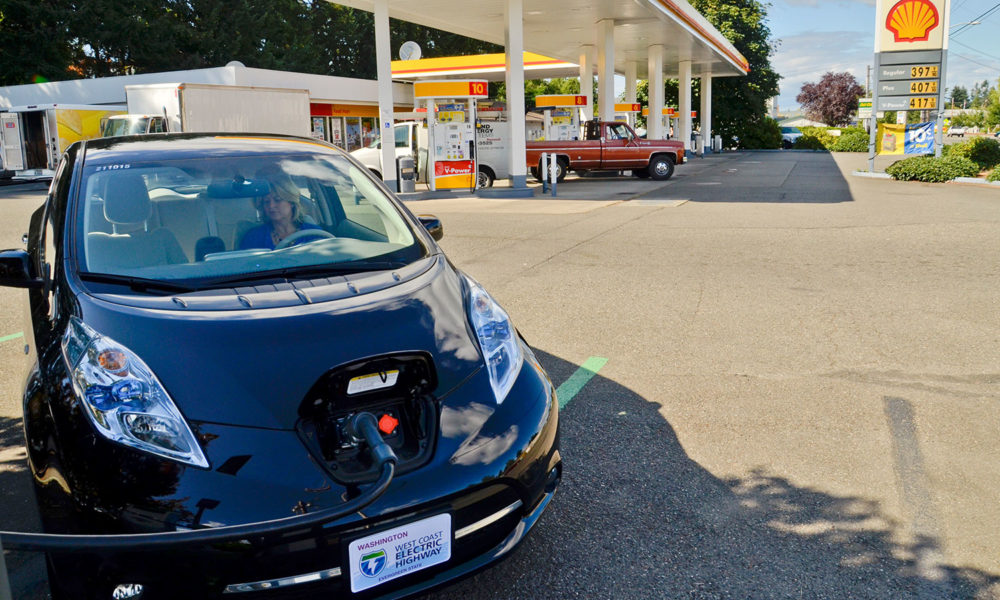UPDATE: Get the latest numbers.
Electric vehicles have a high profile right now, with EVs featuring prominently in the Biden administration’s and Congress’s plans and also important new vehicle announcements from major automakers like Ford. But what are the climate benefits from switching from gasoline to electricity? While it’s obvious that a fully electric vehicle eliminates tailpipe emissions, people often wonder about the global warming emissions from generating the electricity to charge an EV. The latest data confirms that driving on electricity produces significantly fewer emissions than using gasoline.
Electricity power plant emissions data for 2019 was released earlier this year and I combined that data with the latest assessments of fuel emissions and vehicle efficiency. Based on where EVs have been sold to date, the average EV driving in the US produces global warming pollution equal to a gasoline vehicle that gets 93 miles per gallon (mpg) fuel economy. That’s significantly better than the most efficient gasoline car (59 mpg) and far cleaner than the average new gasoline car (31 mpg) or truck (23 mpg) sold in the US. And our estimate for EV emissions is about 15 percent lower than our estimate from just three years ago. Now 97 percent of people in the US live where driving an EV produces fewer emissions than using a 50 mpg gasoline car.
EV emissions are lower across the country

To compare the climate-changing emissions from electric vehicles to gasoline-powered cars, we analyzed all the emissions from fueling and driving both types of vehicles. For a gasoline car, that means looking at emissions from extracting crude oil from the ground, moving the oil to a refinery, making gasoline and transporting gasoline to filling stations, in addition to the tailpipe emissions from combusting the fuel in the engine.
For electric vehicles, the calculation includes both power plant emissions and emissions from the production of coal, natural gas and other fuels power plants use. Our analysis relies on emissions estimates for gasoline and fuels production from Argonne National Laboratory (using the GREET2020 model) and power plant emissions data released by the US EPA. The data, released in February 2021, tallied the emissions from US power plants during 2019.
When looking at all these factors, driving the average EV is responsible for fewer global warming emissions than the average new gasoline car everywhere in the US. In some parts of the country, driving the average new gasoline car will produce 4 to 8 times the emissions of the average EV. For example, the average EV driven in upstate New York has emissions equal to a (hypothetical) 255 mpg gasoline car. And in California, a gasoline car would need to get 134 mpg to have emissions as low as the average EV.
Compared to our analysis from three years ago that used 2016 power plant data, emissions from EVs are on average 15 percent lower. The reductions have come from two primary sources:
- The emissions rate from power plants in the US fell over 11 percent between 2016 and 2019. The drop comes from lower generation from coal and increases in natural gas, wind, and solar.
- The average efficiency of EVs sold to-date in the US improved since our 2018 analysis (by about 6 percent). This was due to the sales of Tesla’s Model 3, one of the most efficient vehicles on the market. The Model 3 now makes up more than 20 percent of all EVs (and more than one third of battery electric cars) ever sold in the US, so its efficiency has a noticeable impact on calculation of average EV efficiency.
A decade of improvement
The change from our first analysis of global warming emissions from EVs and gasoline vehicles in 2012 (using 2009 powerplant data) is even more impressive. In our initial assessment, less than half the US lived where an EV produced fewer emissions than a 50 mpg car, while now nearly all of the US falls in that category. The improvement has been driven partially by increasing EV efficiency, but the major contribution has been from the reduction in electricity generation from coal power plants. Electricity from coal has fallen from 45% to 23% in just a decade. At the same time, solar and wind electricity has grown from less than 2% to 9% in 2019.
| 2009 | 2016 | 2019 | |
| Fraction of US population living in a “Best” region for EVs (>50 mpg equivalent) | 45% | 75% | 97% |
| Fraction of electricity grid regions where an EV is lower emission than a 50mpg vehicle | 9 of 26 | 16 of 26 | 23 of 26 |
| Fraction of US electricity from coal power plants | 45% | 30% | 23% |
| Fraction of US electricity from wind and solar power | 2% | 7% | 9% |
Car buyers have options to be even cleaner by choosing a more efficient EV

The average EV is cleaner than the average new gasoline vehicle everywhere in the US. But if you choose the most efficient EV available, your emissions reductions from switching from gasoline to electricity will be even higher. For example, driving the 2021 Tesla Model 3 Standard Range Plus (0.24 kWh/mile) in California has emissions equal to a 177 mpg gasoline car, or less than a fifth of the global warming emissions of the average new gasoline car and over 65 percent less than even the most efficient gasoline car. And in upstate New York, the emissions from driving an EV can be as low as one tenth those of an average new gasoline car.
As the grid continues to get cleaner, EVs, both new and used, will get cleaner as well. This is a distinct advantage EVs have over gasoline fueled vehicles: their emissions get better over time as the grid gets cleaner. Gasoline vehicles’ fuel economy is fixed and therefore so are their emissions, as long as they rely primarily on petroleum for fuel.

Larger EVs can still lead to lower emissions compared to gasoline equivalents
Larger EVs, like SUVs and pickup trucks are slowly becoming available, and more are promised soon, including an electric version of the Ford F-150 pickup truck. Larger vehicles, whether gasoline or electric-powered, are less efficient. However, switching from gasoline to electricity still has an advantage.
Take for example the upcoming Ford F-150 Lightning all electric pickup truck. The official efficiency data is not yet available, but based on the range and charging performance information released by Ford, we estimate the efficiency to likely be between 0.46 to 0.50 kWh per mile. That would make it one of the least efficient EVs available. However, the average gasoline F-150 model is also inefficient for a gasoline vehicle, with a fuel economy rating around 20 mpg. The Ford F-150 Lightning will produce fewer emissions than the gasoline-powered F-150 while driving, even on the dirtiest electric grids in the US. And on the cleanest grids, the electric pickup will likely be responsible for less than a quarter of the global warming emissions of the gasoline truck. For example, in California, driving the F-150 Lightning should produce global warming emissions equal to an 85 mpg gasoline vehicle, better than any gasoline car or truck. For over 70 percent of the population in the US, driving the electric version of this vehicle should produce less than half the global warming emissions of the gasoline model.
| Ford F-150 EV SUV estimate emissions compared to F-150 gasoline emissions | Greater EV emissions than gasoline version | Up to 50 percent emissions savings with EV | 50 to 75 percent emissions savings with EV | Over 75 percent emissions savings with EV |
| Fraction of US population | 0% | 27% | 59% | 14% |
EVs are one part of reducing transportation emissions
Passenger cars and trucks are a significant source of global warming emissions in the US. Switching from gasoline to electricity is a vital solution for reducing emissions and avoiding the worst impacts of climate change. However, it’s only one of many solutions we need to use. Because many of the cars sold in the next five years will be gasoline-powered, it is important to make sure those vehicles are as clean as possible by having strong fuel economy and emission standards. We can also reduce emissions from combustion-engine powered cars by using cleaner liquid fuel options like biofuels.
Additionally, actions we can take to reduce all driving (whether from gasoline or EVs) will help lower emissions. Sharing rides, using public transit, and making it easier to walk and bike are all important solutions to climate change. But for the personal vehicle trips that we can’t avoid today, switching to an EV can make a big difference in how much global warming emissions we produce aimpnd is one of the biggest actions a household can take to reduce their carbon footprint.

